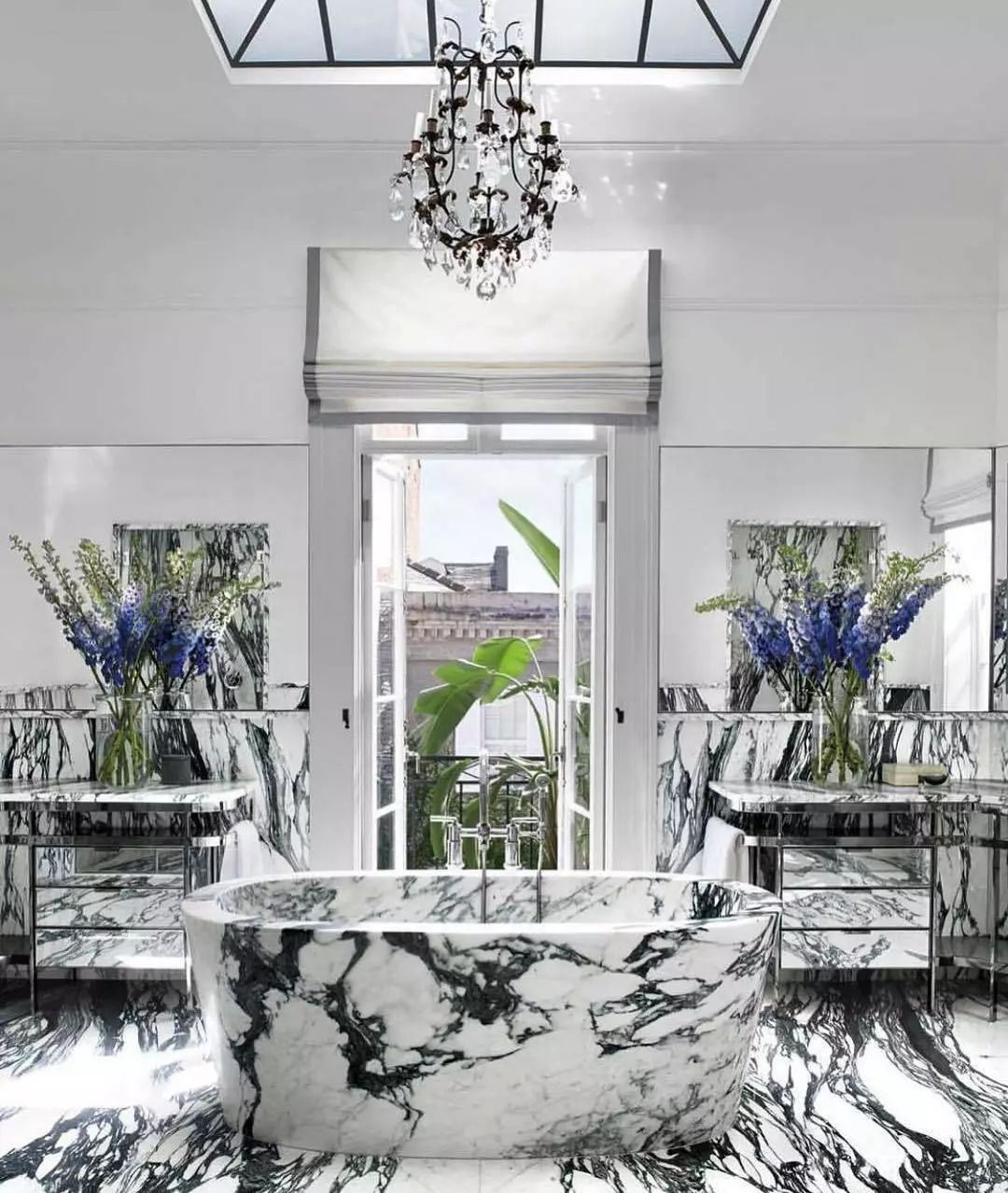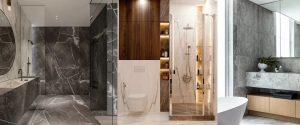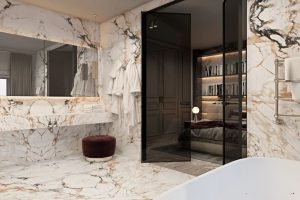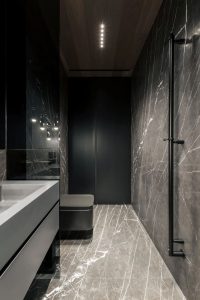
There Are Black, White And Grey Stone Bathroom Design Styles, There Is Always One That Suits You! -
In home decoration design, the bathroom is not only a place to clean the body, but also a space to show the owner’s taste and lifestyle. Natural marble has become the only choice in high-end bathroom design among the other ornamental materials because of its special texture, rich texture, and everlasting aesthetic value. The natural breath and luxurious atmosphere exuded by marble often make people feel happy and relaxed as soon as they enter this space. This is spiritual delight as well as a kind of material luxury. Whether you pursue simplicity and elegance, or love restraint and calmness, or are obsessed with mysterious dignity, marble can easily meet all your needs. In this article, we will explore in depth the unique charm and application skills of black, white and gray marble in bathroom design to provide you with more inspiration and creativity.

Bathroom design uses black, white and gray marble to create different effects
Black marble: the best interpretation of mystery and dignity
As a material full of power and depth, black marble is often used to express a minimalist yet luxurious space atmosphere in home decoration design. Black marble’s unusual lustre and texture always draw people’s attention unintentionally, which makes the bathroom area whole enigmatic and honourable seem.
In bathroom design, the use of black marble can be said to be extremely challenging. Black marble has a noble and frigid quality, but if used incorrectly it may easily make the area seem excessively gloomy or boring. Black marble is therefore typically matched by some metal, mirror, or wood element by designers so balancing the weight of black and provide a sense of layering to the area.
For example, in a modern bathroom design, you can choose a whole black marble wall, matched with metal faucets and mirrors, which not only retains the mystery of black marble, but also enhances the brightness and luxury of the entire space through the reflective effect of metal. Furthermore quite appropriate for harmonising with neutral tones like white and grey is black marble, which leaves a strong impression by colour contrast.
It is worth mentioning that black marble has another advantage that cannot be ignored, that is, its durability and stain resistance are excellent. Black marble can not only preserve long-term beauty but also help to ease everyday upkeep in a bathroom used extensively. Black marble is surely a great alternative for those owners who value texture and features.

The bathroom design uses black marble to create a simple and luxurious space atmosphere

The bathroom design features black marble walls, paired with metal faucets and mirrors
White marble: a simple and elegant space magician
White marble is known as the “space magician”. Its pure color and delicate texture can always inadvertently magnify the visual effect of the entire space, making people feel as if they are in a pure and flawless dream. White is for many people purity, peace, and elegance. Thus, the use of white marble always makes the bathroom radiate an unearthly dignity.
White marble is particularly suitable for use on the walls or countertops of the bathroom. Its smooth texture combined with natural light may provide a clear and translucent area, therefore giving people a new and refined impression. In addition, white marble is also highly adaptable and can be matched with almost any color of furniture and decorations. Whether it is cold-toned metal accessories or warm wooden elements, white marble can blend effortlessly and enhance the harmonious beauty of the overall space.
However, despite the many advantages of white marble, designers should also be cautious when choosing white marble. Because white is easier to get dirty and is prone to discoloration due to water stains or stains when used on the ground, white marble is more suitable for walls or countertops rather than floors. This not only preserves white marble’s natural beauty but also helps to avoid problems in daily usage.

Delicate texture of white marble in bathroom design stone

Pure tones of white marble in bathroom design
Gray marble: an expert in restrained and calm style
Grey marble’s subdued temperament and low-key elegance have helped it to occupy an ever more significant role in modern home decoration. Compared with the purity of white marble and the mystery of black marble, gray marble emphasizes a neutral beauty. Though it is neither extravagant nor excessively chilly, in a mild environment it exhibits an amazing style.
Gray marble has a wide range of applications. Whether it is modern minimalist style, industrial style, or new Chinese style, gray marble can achieve its own unique spatial effects. Grey marble especially in bathroom design may not only highlight space’s layers but also provide the whole design a peaceful and quiet environment.
In addition, the texture of gray marble is also very rich. Every texture, from soft lines to strong abstract designs, can provide the space original visual components. Grey marble paired with other colours will not only accentuate the main color’s vividness but also will not capture too much visual attention. Grey marble becomes more distinctive in house decoration using this “point and stop” design approach.
Another advantage of gray marble is that it has good stain resistance and relatively simple daily maintenance. Grey marble is thus an attractive and useful choice whether it is laid over a big area or decorated locally.

Gray marble in bathroom design creates a calm and peaceful atmosphere

Bathroom design gray marble shows the level of space
As an ancient and noble decorative material, natural marble can inject an unparalleled luxurious atmosphere into the bathroom space both in terms of visual effect and usage experience. The simplicity and elegance of white marble, the subdued peacefulness of grey marble, and the enigmatic majesty of black marble have their own virtues that would satisfy owners with various tastes and styles. Every designer should consider how to mix the beauty and utility of marble in their work. Through reasonable matching and application, we can create a bathroom space that is both beautiful and practical, so that the unique charm of marble can be perfectly displayed in daily life.
Frequently Asked Question (FAQ)
How should I care for my natural bathroom stone?
To maintain bathroom stone, it is essential to determine the hardness of the water and use certified products to remove deposits and stains. Reducing water absorption and adhesion between silt and stone is advised by a penetrating stone protector. Two sort of protectors are advised: fluorinated polymer and penetrating silicone solvent. Prepare the stone surface with a clean cotton towel and brush before applying the protector using premium sponges or plastic films. Dry it for twenty-four hours before using.
After each use, the stone surface should be cleaned based on the specific stone, use environment, pollution source, and cleaning agent. For plant stains, use a two-component enzyme cleanser or a neutral marble cleaning product combining hydroxyethyl cellulose, silicate, and fragrance. Should stains remain, combine an enzyme cleanser solution with decontamination powder and treat the affected area.
Regularly polish the marble surface to prevent further damage. Although maintaining polished stone requires more time and work than maintaining fibreglass, the elegance and grandeur of natural stone décor cannot be equipped with any other.




